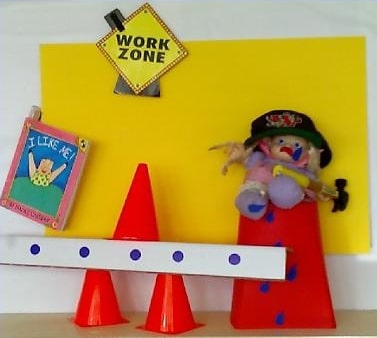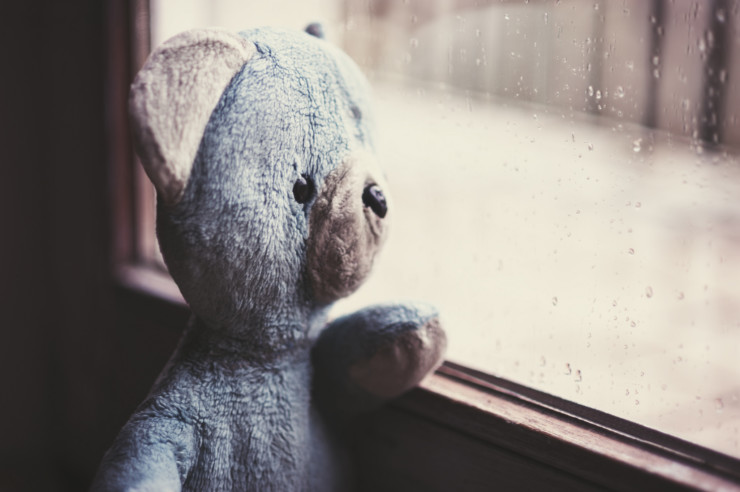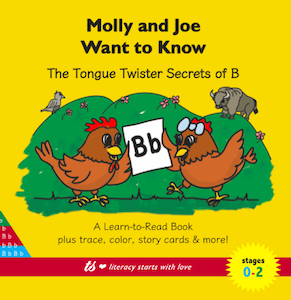Editor’s Note: Literacy is a term we use to describe a person’s ability to read, comprehend, and express themselves through the written word. There is another form of literacy, however, that has been shown to be more important to happiness and success in life than a person’s intelligence: emotional literacy. Emotional literacy is the term used to describe a person’s ability to understand feelings, and express them. Today, Donna Falcone draws on her early childhood education experience to introduce you to Bobbie, and show you how she helped children practice and build emotional literacy skills in the preschool classroom.
In 2007 I had the good fortune of teaching the youngest students at a private school, now a charter school, in Scranton, PA. Two mornings each week my classroom would fill with two- and three-year-olds who came to play, sing, snack, and share our sunny, soft spaces.
Every day at noon, after the toddlers had gone home, 25 four- and five-year-olds burst into the room for lunch, stories, play, and rest, following a busy morning in Montessori classes.
On one toddler-free morning, one of my four-year-olds (let’s call her Mary) came to my classroom with her mom for an important talk. I could see tension on her face. Mary was angry and her mom was helping her bring her concern to me. Together they told me what had happened the day before.
Mary’s mom explained that two children (we’ll call them Martin and Amanda), had teased Mary about her Buzz Lightyear sneakers. Mary nodded, wide-eyed, as her mom recounted the whole story to me. This mom and this child were remarkably in tune. It was as if Mary was telepathically speaking through her mama’s lips. Together, they shared that Martin and Amanda told had Mary, in a not so friendly way, that Buzz Lightyear was not for girls. Mary’s mom was quick to say that she didn’t want to cause a problem for the children. She just wanted me to be aware of what had happened because it was important to Mary.
“They told Mary,” her mom reported with a very distraught expression and wide eyes, locked on Mary’s, “that she was wearing boy shoes.”
We paused to consider the gravity of Mary’s feelings.
“And they laughed at me!” Mary nearly shouted.
Mom and I glanced at each other, trying not to overreact, both knowing what a victory this was for Mary, who was often uneasy with speaking out. I told Mary that it was a good thing to tell me this whole story, and I was so sorry that she had had such a hard time the day before.
I thanked them for coming in, and promised I would keep a close eye on things. I told Mary it’s not tattling if someone is hurting you or someone else, so please come and tell me if it happens again and I’ll help you. She agreed and Mary’s mom took her to her Montessori classroom.
In a moment of inspiration, I remembered a technique my friend and mentor taught me in graduate school. I got to work digging through the supply closets for a doll the children had never met before and some props that would help tell a story. Certain that Mary was not the only person in the room who had ever been teased, rather than single her out and risk shaming the other children involved, I decided to invite everyone to talk about teasing.
As the children poured in, they immediately noticed the new doll, perched on a shelf at eye level in front of a backdrop of a yellow WORK ZONE sign and bright orange construction cones. She held a hammer in one hand and her blonde pigtails peeked out beneath a black baseball cap. Blue tears were suspended on her noticeably sad face. I gathered the group for a quick meeting to introduce our new friend before lunch time.
“This is our new friend Bobbie, and she’s very sad today,” I told them with a heavy sigh. Many little faces fell at the thought of a sad doll, and I thought little Rhea might cry herself. “Bobbie is not to play with, so you can look, but don’t touch,” I added with a smile and a wink. “Maybe she will tell us her story after lunch.”
Before we knew it, upwards of 50 hands were washed and 25 lunch boxes were being unzipped and explored. The smells of fruit roll ups and cheese sandwiches filled the room. After lunch, we cleaned up and hurried to our meeting place. The children sat waiting for my classroom assistant, Sam, and I to catch up with them, buzzing about Bobbie and why she was sad. I carefully lifted the doll into my arms as if she were a human child, rubbing her back as I brought her to my ear. She “whispered” to me, and I, in turn, relayed her story to the children in a most dramatic voice.

Bobbie, the preschoolers’ emotional literacy doll in her “construction zone”
“She was playing builder…” I said, “and having a great time!” More whispering in my ear. “Then…” I looked surprised. “What’s this?” More whispering. “Some kids teased her!” The children gasped! “They told her only boys can do that.” My voice was filled with pain. “They told her only boys can wear those clothes and only boys can be builders in the construction zone.” My wide eyes exposed my shock and sadness. I held Bobbie close.
The children, including Mary in her Buzz Lightyear sneakers, had a lot of suggestions for Bobbie. “You should hug her,” Amanda said, right off the bat. “You should give her a piece of Halloween candy,” shouted a little boy. Finally, Mary sprung up on her knees as if she might pop and proclaimed “People should be nice to each other!” Everyone agreed.
It’s true that classroom teasing decreased significantly after Bobbie’s arrival, but other issues cropped up over time and she was there to help the children along the way. When Jake was out of sorts about moving to a new house, Bobbie was coincidentally faced with packing and moving too. When Bryan was suddenly afraid to sit with the whole group in circle time, following a fall at home that sent him to the emergency room, Bobbie was suddenly injured and laid up in bed for days. When I was frustrated with my own hearing loss, Bobbie talked to the children about how her ears bothered her, and how too much noise made her cry.
This was more than creative storytelling. The strategy of using dolls to help children talk about feelings was purposefully designed to help children understand themselves and develop compassion by relating to their own experience. Over the next several months, Bobbie helped the children practice powerful emotional literacy skills: identifying feelings, listening to others, feeling empathy, showing compassion, and problem solving.
To learn more about using dolls to help children talk about feelings, and Bobbie’s classroom adventures:
Using dolls to support children’s social-emotional development. Jacobson, T. & Falcone, D. (2009). Teaching Young Children. Vol. 3, No. 2, pp. 8-10. Washington, DC: NAEYC
Persona Dolls. Rotondo Bisson, Julie. 2001
Don’t Get So Upset: Help Young Children Manage Their Feelings by Understanding Your Own. Jacobson, Tamar Ph.D. 2008
Teach It: Mixed Emotions in Civil Rights, by Callie Feyen
Teaching Emotional Literacy. Elias, Maurice J. Edutopia. September 9, 2013
Five Simple Lessons for Social and Emotional Learning for Adults. Aguilar, Elena. Edutopia. May 20, 2014
Browse more Literacy resources
Photo by 55Laney69, Creative Commons license via Flickr. Post by Donna Falcone.
- From Artist’s Way to Museum Art Camp - November 14, 2018
- 10 Surprising Ways to Help a Child Learn to Read - April 26, 2017
- Emotional Literacy in the Preschool Classroom - March 2, 2017


L.L. Barkat says
Yes, great story! I can just see you doing this 🙂
Also, it’s reminding me of our Curious book club, since you actually used a technique that piqued their curiosity… and also because Ian Leslie talks about how that pysch fMRI study “concluded there was substantial overlap between the neural networks we use to understand stories and the ones we use to navigate our relationships.”
Donna Falcone says
I will definitely need to go back and catch up on my reading – you have made me curious! 🙂 Thank you. The dolls were magical.
Donna Falcone says
This is strikingly similar to the work of a writer who strives to show and not tell. With the dolls, the doll can SHOW rather than the teacher TELL (otherwise known as lecturing, shaming, nagging, or giving a talking to). It seems to be a parallel literacy element.
L.L. Barkat says
Yes! Love that observation. You are reminding me of Sara’s discussion of how stories affect us through the phenomenon of neural coupling. She goes on to say, “it means that the storyteller can literally influence the state of mind of the listeners.”
See: https://www.tweetspeakpoetry.com/2015/04/10/why-do-people-like-tragedy-and-comedy/
Donna Falcone says
Wow. She can really pull a piece together, your Sara. That is brilliant. I was reading her reference #1, regarding the fMRI study, and this jumped out at me as support for the social perspective of Vygotsky’s scaffolding model – “We used the speaker’s spatiotemporal brain activity to model listeners’ brain activity and found that the speaker’s activity is spatially and temporally coupled with the listener’s activity. This coupling vanishes when participants fail to communicate.” and so that’s just amazing.
Connection is important. The Dolls ‘work’ because each and every scenario used in the classroom was born out of an actual even that happened to a child or children in that group – or their teacher (like when I lost my hearing in one ear). Connection to the story and the fictional telling of it, right there with a real ‘live’ doll makes it happen.
Interesting thought regarding the findings that link frequency of social media usage to depression – the stories are there, but the connection, not so much in varying degrees.
L.L. Barkat says
Yes, truly amazing how we are built to “hear” one another through stories, through this brain-mirroring process. Now I am wondering what he means by “fail to communicate.”
L.L. Barkat says
Also, could you say more about… “support for the social perspective of Vygotsky’s scaffolding model”? 🙂
Donna Falcone says
I think he means fail to communicate in the sense of failing to make a connection – strike a ‘nerve’ (which is more literal than we ever knew, eh? 🙂
I took that connection out of the context of his study and into a learning opportunity with a child – the dolls was a scaffolding event that was able to reach the children wherever they happened to “be” experientially” at the time. Some had never teased. Some had recently teased. All had been teased at one time or another, or had felt sad about words people used. That was the hook, you might say. Vygotsky might say they were all in unique zones of proximal development, meaning they had some existing knowledge of teasing and the feelings it induces. The story of Bobbie pulled all of them in because they could all relate to something she ‘said’ to me… and of course the tears. (Some might say that my adding the actual tears was a bit intrusive, and they may be right. The children may have had more freedom to interpret her response had I left her tearless, but I wanted to act quickly (zones don’t last forever LOL) and this is what came out. But it worked.)
I think the the social context, the interactive story telling, is what Vygotsky would have seen as crucial in lifting them to a higher level of understanding from where they currently stood… with primary support coming from that very foundation…. like a scaffold.
Donna Falcone says
…and, I never had to say “we should be kind… teasing is against the rules.” That’s the point of the dolls…. the children usually collectively arrive and brilliant conclusions as they talk about the situation our doll is in that day. They progress in becoming socially competent and accountable with this practice, and they create their own inner rules as we move along… it’s a form of self governance, isn’t it? Teacher guided, but what an opportunity!
L.L. Barkat says
I’m thinking about a parenting book I read once, where the writer talked about using the child’s name in an on-the-fly story at bedtime, to debrief about the day. But I like the idea of tweaking that a little. Maybe the child has a doll that the child uses to “tell one story from her day” with—perhaps sometimes done at dinner time and other times done at bedtime.
Donna Falcone says
What a wonderful tweak… Sweettweak. 😉
Will Willingham says
I love this story. And I love the way using the dolls allowed the kids to empathize with Bobbie’s situation without having to get their defenses up about what they may or may not have done. 🙂
Donna Falcone says
Thank you, LW. The dolls were so powerful.
Sandra Heska King says
This is so, so good. I’m thinking right now about young friend who suddenly lost her husband last week in a tragic accident that her four young children witnessed. I hope someone incorporates dolls in their classrooms and grief work.
Whatever happened to Bobbie?
Donna Falcone says
Dolls can be used very effectively with the delicate work of grieving. I think it would work brilliantly in a classroom to help the children with their re-entry – Oh my goodness… goosebumps.
An interesting fact is that there was (maybe still is) a program in Israel that used the dolls to help children cope with living in areas that had been bombed. My friend who taught me came from Israel, actually.
Bobbie was like a person, in many respects, and so I left her there when I left the school mid year. I didn’t have the heart to remove her, and thought the children might need her. I also hoped someone would carry on with her. I have no idea if anyone did, though, and when I tried to get her back a year later she was no where to be found. Sigh. I took my work with the dolls to my next place of employment where I worked with teachers …. we were beginning to implement it there, but then I left. I’m not sure what happened or if the teacher I had trained to use the dolls, or the one who was ready to being with dolls ever continued.
Bethany R. says
Love this, Donna! I like how you primed the curiosity of the class by introducing the sad doll early on. That way they were eager to figure out what was bothering her.
Kids are naturally able to imagine—with conviction—that dolls and stuffies are real. What a beautiful approach to addressing difficult and painful issues.
Donna Falcone says
Children are so good at that. AND, though they knew she was a ‘toy’ they never tried to play with her – she seemed to possess the boundaries of personal space for them. Oh, and if anyone touched her to get a closer look… well, alarms rang up all over the room in the form of children’s voices!
Michelle Ortega says
Wonderful read, Donna! And a powerful construct for conflict resolution. When each party can empathize with the other, a foundation for listening is perhaps stronger. Many times we can just jump to the conflict, without the skills or understanding of empathy. You modeled the pathway for the children without blame or shame or fear, and allowed them to build and repair the relationships by what they experienced with Bobbie. Brava!
Donna Falcone says
Thank you MIchelle! I really appreciate your comment. 🙂
It’s so easy to blame and finger wag, which becomes a personally engraved invitation for defensive moves and evasive action.
Bobbie did a lot for me, too.